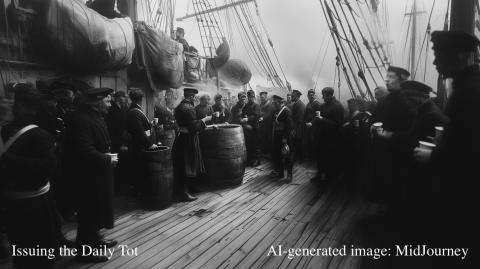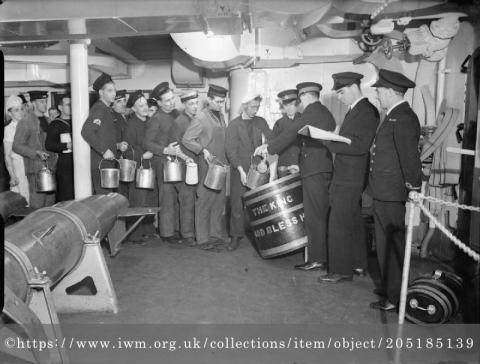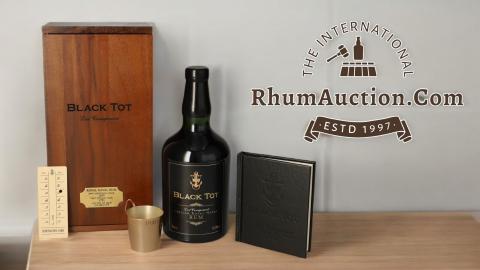Introduction
Have you ever heard of ‘Black Tot Day’?
On July 31, 1970, the British Royal Navy ended a tradition that had been part of daily life for over 300 years—the issuing of a daily rum ration to its sailors. This day, forever known as Black Tot Day, marked the end of an era, where rum played a vital role in life at sea. In this post, we’ll take a closer look at the fascinating history of this tradition, why it came to an end, and why Black Tot Day remains a special date for rum enthusiasts around the world.
The Origins of the Rum Ration
The daily rum ration in the Royal Navy has a fascinating origin, rooted in both practical necessities and historical events. In the 17th century, sailors faced a serious problem: fresh water stored in barrels on ships would quickly spoil, becoming undrinkable. To address this, alternative beverages were introduced. Beer was one option, but it took up a considerable amount of space on board—a significant logistical challenge, particularly on long voyages.
It was soon discovered that drinks that had undergone fermentation or distillation were not only safer to consume but also stayed fresh for much longer than stagnant water. Initially, brandy was provided to sailors, but after Vice Admiral William Penn captured Jamaica from the Spanish in 1655, the Navy began to switch over to the abundant local spirit—rum. This marked the beginning of rum’s long-standing association with the Royal Navy.
The Evolution of the Rum Ration
By 1731, sailors were officially receiving a daily ration of half a pint of rum. However, in 1740, Admiral Edward Vernon made a key change. His Order to Captains No. 349 on August 21, 1740 reduced the ration to a quarter pint, diluted with water and split into two servings—one before noon and one at the end of the day.
This watered-down rum became known as Grog, named after Vernon's nickname "Old Grog," due to the grogram cloak he wore. While it's often believed that Vernon added sugar and lime to the mix, this is a common misconception. Although sailors could purchase sugar and lime at their own expense, these ingredients were not part of the standard issue. Instead, lemon juice (later in powdered form) was given separately to combat scurvy, thanks to its Vitamin C content.
Despite popular belief, the Grog recipe didn't resemble a precursor to the modern Daiquiri, as many like to imagine. The officers, however, were allowed to drink their rum undiluted, until even they were eventually denied the ration to maintain a clearer head for command.
Image

Formalizing the Rum Blend (1810)
By 1810, the Royal Navy had formalized the exact blend of rum that would be used for the daily tot. This was an important shift, as the Navy wanted to ensure a consistent and reliable supply of high-quality rum for its sailors. The contract to supply this rum was awarded to the British trading company ED&F Man, led by James Man, who played a significant role in securing the Navy's rum supply.
Image

The blend typically consisted of Caribbean rums, primarily sourced from British colonies such as Jamaica, Barbados, and Guyana. These regions were renowned for producing some of the finest rums in the world, and the Royal Navy saw this as a way to maintain the quality of the tot that sailors had come to rely on.
As the rum blend became standardized, the daily tot continued to be a key part of naval life, providing not only a source of comfort on long and dangerous voyages but also serving as a reward for sailors' hard work and dedication.
The Decline of the Rum Ration
As the 19th century progressed, attitudes towards alcohol consumption in the Royal Navy began to change. By 1824, the daily rum ration was reduced once again, reflecting concerns over discipline and the potential negative effects of alcohol on sailors’ performance. While rum continued to be a cherished tradition, it became clear that the changing needs of a modernizing Navy required more control over alcohol consumption.
Throughout the 19th and early 20th centuries, the role of the rum ration was increasingly debated within the ranks of the Navy and among British officials. On one hand, it remained a valued part of the daily routine, symbolizing camaraderie and offering a much-needed respite during long, grueling voyages. On the other hand, concerns about alcohol’s impact on discipline and efficiency led to calls for reform.
The Great Rum Debate of 1970
By the time the 20th century rolled around, modern technology and military practices were shifting. The need for sailors to remain clear-headed and focused in the increasingly technical roles aboard ships grew, and the rum ration was seen as an outdated tradition.
This culminated in the Great Rum Debate in Parliament on January 28, 1970. During this session, British lawmakers debated whether the daily tot should be retained or abolished. Ultimately, the decision was made to end the rum ration, with concerns about naval discipline and safety outweighing the nostalgic ties to tradition. The Parliament officially declared that the last rum ration would be issued on July 31, 1970.
Image

Black Tot Day – July 31, 1970
On July 31, 1970, known forevermore as Black Tot Day, the Royal Navy issued its final rum ration to sailors. The day was marked with both solemnity and celebration. Some sailors wore black armbands, while others held mock funerals for the tot, throwing their cups overboard in protest. For many, this day represented the end of an era—a farewell to a tradition that had been part of naval life for over 300 years.
From that day forward, no British sailor would receive a daily rum ration. The remaining stock of Navy rum was carefully preserved, some of which was later used to create commemorative blends, like the famous Black Tot - Last Consignment.
To give you a clearer picture of the significant moments that shaped the history of the Royal Navy rum ration, we’ve created this timeline infographic. It highlights the key dates, from the introduction of rum into the Navy in 1655 to the final Black Tot Day in 1970.
At our auction RCA2024-10, we are proud to present one of the rare Black Tot "Last Consignment" bottles.
Sources:
https://pussers.com/pussers-history/




